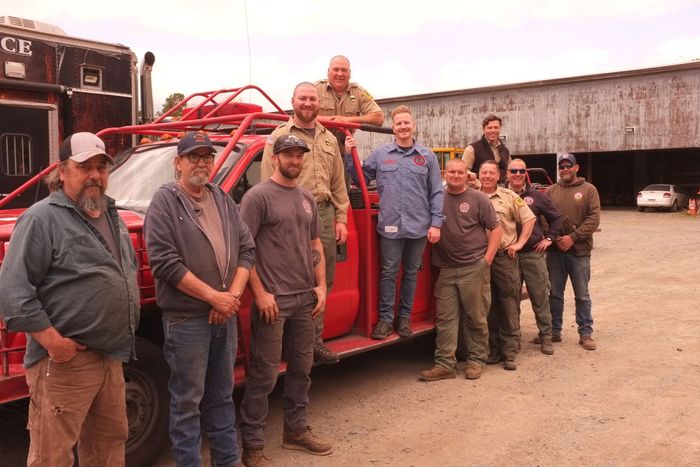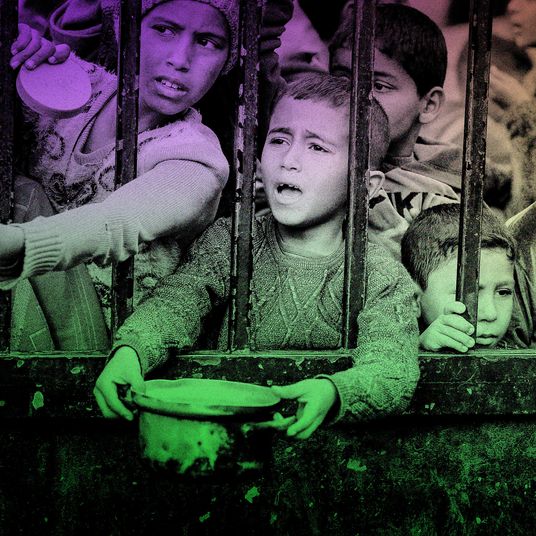By April 11, the cranberry bogs in New Jersey’s pinelands were as low as farmers had seen them in decades. Central and southern parts of the state had been experiencing abnormally dry conditions for more than a year, and dead grass, branches, shrubs, and leaves carpeted the forest floor like crinkled up paper bags. It was a sunny Tuesday afternoon, with low humidity and wind gusts that reached 25 mph. The National Weather Service called it a Red Flag day; forest firefighters called it “a good fire day.”
At 4:12 p.m., John Walter Earlin, a section warden of the New Jersey Forest Fire Service, received a call about a fire at Joint Base McGuire-Dix-Lakehurst, a 42,000-acre military-training installation set in New Jersey’s 1.1 million–acre Pinelands National Reserve forest. By the Pentagon’s tally, the military ignites one fire every two weeks on the base, which is to be expected when training soldiers to use grenade launchers in, by its own estimation, “one of the most flammable areas in the country.” Usually, fires are suppressed on-site by the base’s fire department, but they do occasionally spread onto civilian property. The biggest Pinelands wildfire in recent history, which burned 17,000 acres in 2007, was caused by a flare dropped by an F-16 at an artillery practice range 20 miles south of the base.
This fire ignited in an area of the base called Jimmy’s Waterhole. When Earlin arrived, he saw about 25 members from the base’s fire department working to contain the blaze. About an hour later, satisfied that it had been, he headed home for the night. Earlin barely had time to shower and make a sandwich before his phone rang again: “They said, ‘You gotta come back! You gotta come back! It’s jumped over to you guys!’” Barely two hours after the initial phone call, Earlin was driving down the road separating the base from the forest, where he saw a “boiling column” of fire topping 200 feet to the east. The fire was moving at nearly 5 mph — too fast for firefighters to attack head-on. “I’d never seen fire behave like that at night,” he said.
Earlin called his superiors to tell them they had a rager and, soon after, NJFFS chief Greg McLaughlin was standing at the fire’s northeast edge on Division Street in Lakehurst. On one side of the street was pineland forest, and on the other side were rows of idyllic four-bedroom homes with families asleep inside. McLaughlin turned to one of his deputies. “We’re fucked,” he muttered.
The Pinelands National Reserve is a big reason why New Jersey’s forest-fire service is among the most active in the northeast, with 68 full-time employees and nearly 1,000 part-time firefighters, lookouts who take shifts in 21 fire towers around the state, four garages that fit their Mad Max–style trucks, and an aviation wing that includes helicopters and airplanes. McLaughlin’s crews worked through the night putting out spot fires ignited by floating embers, lighting backfires to burn fuel ahead of the blaze, and bulldozing fire-stop borders around homes and businesses. Three helicopters dumped thousands of gallons of water on the fires, while another hovered overhead to keep track of the fire’s path. All told, 170 buildings were evacuated. Two days after igniting, the wildfire was contained. Pockets of forest still smoked, and a beaver dam smoldered in a stream, but by then McLaughlin was already focused on putting out wildfires in other parts of the state. All told, the Jimmy’s Waterhole fire scorched 3,859 acres of forest.
Spring is traditionally the start of fire season in the northeast, but this year the NJFFS got its first call earlier than usual, on March 7. It’s been busy ever since. Later that month, Amtrak canceled trains because of a string of brush fires ignited by sparks from a freight train in North Jersey. A few weeks later, the forest-fire service battled three major wildfires in a matter of days, including the Jimmy’s Waterhole fire. Since 1906, New Jersey has averaged 1,500 wildfires burning 7,000 acres a year. In the first four months of this year, 7,914 acres have already burned.
Although rarely disruptive, wildfires have always been a fact of life in the Northeast — Indigenous people along the Eastern Seaboard regularly lit prescribed fires to clear dry and dead vegetation from large tracts of forest. More recently, though, scientists have warned that the Northeast could become more susceptible to wildfires in the coming decades as a result of climate change. The United Nations estimates a 50 percent increase in wildfires worldwide, and while the recent spate of wildfires in New Jersey isn’t necessarily a harbinger of things to come, a 2020 report by the state’s department of environmental protection repeatedly warned that the area could see longer wildfire seasons with more major wildfires like the one started at Jimmy’s Waterhole. “The East will not emerge unscathed from the infernos that are quickly becoming a hallmark of western summers,” wrote climate reporter Kendra Pierre-Louis in The Atlantic last year. That nightmarish future got the Hollywood treatment in the opening episode of Extrapolations, Apple TV+’s attempt to show the ways climate change might change everyday life (or at least the everyday lives of rich westerners) in the coming decades. The show features shots of New York’s Adirondacks in the year 2037 lit up like California’s 2018 Camp Fire. A decade ago, Hurricane Sandy forced Northeasterners to consider the storm damage climate change could wreak in years ahead, but blistering infernos also pose a risk to the most densely packed region of the country.
Just like wildfires out West, drought conditions are key to understanding how bad things could get on the East Coast. Yet over the past century, the Northeast has seen an overall increase in annual precipitation. According to Erin Lane, coordinator of the USDA’s Northeast Climate Hub, the region has seen a 56 percent increase in the number of days with extreme precipitation (defined as exceeding the 99th percentile). Logic follows that the increase in precipitation would lead to a proportionate decrease in drought conditions. However, according to Lane, drought isn’t decreasing as much as one might expect. In between major rainfalls, the Northeast is seeing flash droughts. “So many fire managers think that they’re seeing more fire on the ground and yet the data is telling them that we’re getting more rain. It could be the susceptibility to flash drought that we’re seeing,” said Lane, who, before becoming a researcher, worked as a hotshot in Oregon and rappelled from helicopters into wildfires in Idaho. “It’s defining drought differently than we have in the past. Those flash-drought conditions could have a big impact on wildfires.”
This winter, southern New Jersey recorded just 0.4 inches of snowfall, the fewest on record, and that lack of accumulation may be contributing to the intensity of this year’s wildfires. Ken Clark, a research forester with the U.S. Forest Service based in the Pinelands, theorizes that if the vegetation and organic litter on the forest floor hasn’t been compacted under a heavy layer of snow, then there is more room for oxygen to flow among the pine needles, dead grass, and leaves, potentially feeding ever greater “fuel jackpots,” as firefighters call them. “It definitely makes a big difference in terms of both rate of spread of fire and flame height,” Clark said.
The strange, unpredictable climate — less snow, more heavy rain, flash droughts — appears to be a result of global warming. Still, research scientists aren’t about to issue any definitive statements about the relationship between climate change and wildfires in the Northeast. “There’s no rhyme or reason in terms of any trends right now,” Dave Robinson, New Jersey’s state climatologist, said. “But if we begin to see these events more frequently, ten or 20 years from now, we may say that looking back, this was the beginning of a notable change.”
On the ground, climate change may have already altered the characteristics of wildfires in the Northeast. “Some of the things we’re seeing out there are really surprising us,” McLaughlin told me. “And there seems to be no other explanation than climate variability.” McLaughlin, who holds a masters degree in plant biology and owns a tree farm in North Jersey, says southern pine beetles, rice-size insects that have crept up the Eastern seaboard over the past two decades thanks to warmer winters, chewing up swaths of forest along the way, have made an already perilous job even more so. “You push a live tree over, and it falls over as you would expect. But if you hit a dead tree, it breaks in half and falls back on you,” he said, describing the way the NJFFS’s trucks use custom-fitted rail guards to push trees over. “The number of broken windshields and caved-in roofs that we’ve experienced over the past several years has gone up.”
Whenever wildfire conditions are right, as they have been most days this spring, Sam Moore ascends a 105-foot fire tower in Medford and scans the treeline for smoke. Just 19 years old, Moore is one of the youngest employees of the service, and his khaki uniform hangs on his lanky frame like a shirt pitched on a sapling to dry. His position as a fire observer is part-time, but Sam Moore IV hopes one day to be a full-time forest fire warden, just like Sam Moores III, II, and I before him.
Standing just 50 yards from a busy road in a bedroom community, the tower itself looks like an anachronism. From up top, on a recent Tuesday afternoon, Moore can see the Philadelphia skyline 20 miles to the west. All around him is a carpet of green and yellow, the crowns of tightly packed cedar, oak, and pine rooted in sandy, acidic soil. Below the canopy are countless businesses, cabins, split-level homes, and million-dollar mansions whose owners, whether they know it or not, count on spotters like Moore to protect them from the tinderbox they call home.
“We got smoke,” Moore says, reaching for a pair of binoculars resting next to a half-gallon of Wawa iced-tea. He focuses the lenses on a locket of white smoke to the north and watches to see if it turns black or expands quickly, sure signs of a nascent wildfire. He puts the binoculars down and steps behind a spotting scope attached to an alidade, a lazy Susan–like turntable map that helps him determine the fire’s bearing. He calls another observer in a tower on Apple Pie Hill, 11 miles to the east, and within a minute, they triangulate the smoke’s approximate location. “It’s right around Bud Bud’s house,” he says. Moore knows the area well — it’s a few short miles from the cranberry bog and blueberry farm where he grew up.
Two minutes later, the wisp is already dying down. “It’s gotta be a pile,” he says, explaining that the smoke was likely from a fire lit by a resident, probably without a permit, to burn up some landscaping detritus on their property. He doesn’t think it’s a wildfire, and sure enough, the smoke soon disappears altogether, taking Moore’s sense of urgency with it.
Later that day, a cadre of NJFFS firefighters escort me to the part of the forest where they’d filmed a harrowing video of flames soaring higher than a stand of pines during the Jimmy’s Waterhole fire. We caravan down a half-mile of sandy road in their trucks and arrive at a swamp ringed by charred pines and blackened earth.
I ask Shawn Judy, a division warden, if he thinks climate change was at work during the Jimmy’s Waterhole fire. “Things are changing, or maybe shifting,” he says. “I’ve never seen a year when we didn’t have so much as one time where the snow covered the ground. The leaves are certainly coming on the trees sooner than they used to, and they’re coming off later. I don’t know what it is, exactly, but there’s something to it.” Judy walks me over to a pine and pulls back a piece of the duff layer, the organic root mat and soil around the tree. “The ground here was all burned out,” he says. “You don’t see that in April. You see it in July or August, but not April.”
As we head back to the trucks, I notice for the first time the sound of songbirds in the canopy, chirping as if the forest below weren’t recently scorched by a wildfire ignited on a nearby military base. Then someone’s radio beeps and crackles. “Hang around long enough and you can go to a fire,” McLaughlin says. “The sun’s out, the wind’s picking up a little. Kids are out of school. It’s the witching hour.”





























